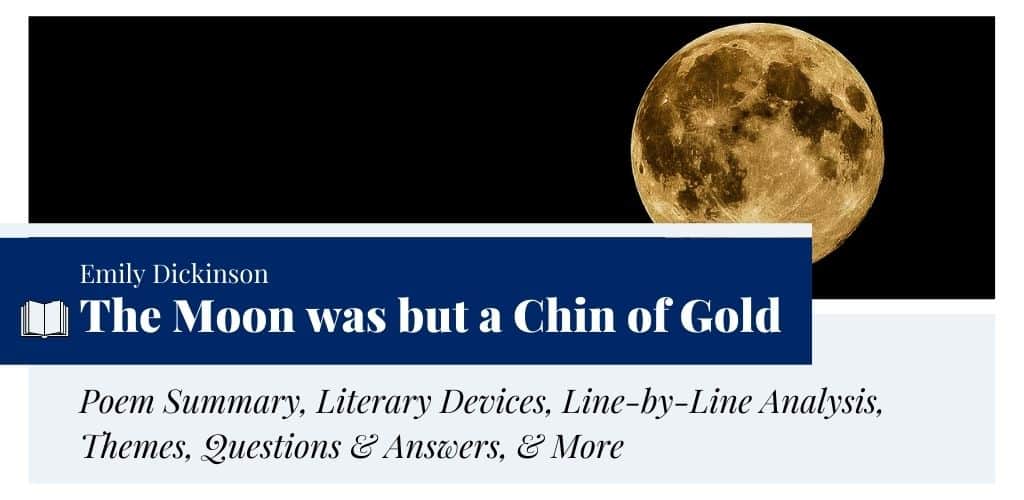The Moon was but a Chin of Gold by Emily Dickinson
“The Moon was but a Chin of Gold,” written in 1863 by one of the highly distinguished figures in American poetry, Emily Dickinson. It was first published in the third series of Poems (1896) in the “Nature” section. This lyric poem contains metaphors, personification, and imagery aplenty. In comparing different stages of the moon to a beauteous woman’s face, Dickinson opens new doors of imagination and teaches readers to observe the world in different ways. In a light, imaginative tone, she personifies the moon as a woman in a beautiful gown, smiling and looking down at the world like a queenly figure. The depiction of the “moon” showcases her keen sense of observing nature.
- Read the full text of “The Moon was but a Chin of Gold” below:
The Moon was but a Chin of Gold (737) by Emily Dickinson The Moon was but a Chin of Gold A Night or two ago – And now she turns Her perfect Face Upon the World below – Her Forehead is of Amplest Blonde – Her Cheek – a Beryl hewn – Her Eye unto the Summer Dew The likest I have known – Her Lips of Amber never part – But what must be the smile Upon Her Friend she could confer Were such Her Silver Will – And what a privilege to be But the remotest Star – For Certainty She take Her Way Beside Your Palace Door – Her Bonnet is the Firmament – The Universe – Her Shoe – The Stars – the Trinkets at Her Belt – Her Dimities – of Blue – - from The Complete Poems of Emily Dickinson (1955)

Summary
“The Moon was but a Chin of Gold” by Emily Dickinson is a beautiful lyric, which opens new corridors of imagination and encourages readers to explore nature innovatively. In this poem, the speaker idolizes the moon on different days of the month as a smiling woman looking down at the miniaturized world. She admires and describes the different phases of the lunar cycle in consecutive stanzas. Dickinson traverses the conventional boundaries of literary associations when she imagines the moon as a lady’s face and the celestial objects like stars as her ornaments and jewels. However, through the glorification of the moon, she also underlines the impression of distance and remoteness between the speaker and the moon.
Form, Rhyme Scheme, & Meter
Form
“The Moon was but a Chin of Gold” is an iconic lyric poem with five quatrains and Dickinson’s trademark use of dashes. It expresses one speaker’s perceptions regarding the moon. She compares the different phases of the moon to a pretty woman’s face. Unlike other poets, Dickinson does not follow any conventional pattern to organize her thoughts but instead designs her own way of expression. She implements the third-person point of view to portray the image of the “moon” as an elegant lady. In this poem, readers can find the poetic techniques of unconventional dashes, capitalization, and slant rhymes to delineate quixotic ways of observing the world.
The use of multiple dashes and unusual capitalizations makes the sudden pauses (caesura) more prominent and engages the readers in the process of imagination along with the poetic persona. While the capitalized words in the middle of sentences catch readers’ attention, the dashes, on the other hand, make them halt and think. Her distinct use of elliptical language shows how ideas that may not be real can be imagined creatively.
Rhyme Scheme
While reading the poem, it appears that Dickinson unpremeditatedly follows the rhyme scheme of ABCB. However, in the opening and ending stanzas, the second and fourth lines perfectly rhyme: “ago” and “below”; “Shoe” and “Blue”. In the rest of the stanzas, Dickinson uses her unique slant rhymes: “hewn” and “known”; “smile” and “Will”; “Star” and “Door”. The presence of a regular rhyme scheme somehow invests a sing-song-like quality to the poem.
Meter
“The Moon was but a Chin of Gold” is also written in a regular meter; Dickinson uses iambic tetrameter and iambic trimeter alternatively. In each stanza, the first and third lines contain eight syllables grouped into four iambic feet. The second and fourth lines have three iambs. In an iamb, the first syllable is unstressed, and the following one is stressed, creating an uplifting tempo of da-dum. Let’s have a look at the scansion of the poem to understand the overall metrical pattern:
The Moon/ was but/ a Chin/ of Gold
A Night/ or two/ a-go –
And now/ she turns/ Her per/-fect Face
Up-on/ the World/ be-low –
Her Fore/-head is/ of Amp/-lest Blonde –
Her Cheek/ – a Be/-ryl hewn –
Her Eye/ un-to/ the Sum/-mer Dew
The li/-kest I/ have known –
Her Lips/ of Am/-ber ne/-ver part –
But what/ must be/ the smile
Up-on/ Her Friend/ she could/ con-fer
Were such/ Her Sil/-ver Will –
And what/ a pri/-vi-lege/ to be
But the/ re-mo/-test Star –
For Cer/-tain-ty/ She take/ Her Way
Be-side/ Your Pa/-lace Door –
Her Bon/-net is/ the Fir/-ma-ment –
The U/-ni-verse/ – Her Shoe –
The Stars/ – the Trin/-kets at/ Her Belt –
Her Di/-mi-ties/ – of Blue –
The rhyme scheme and the set meter make this piece a great lyric to be sung or read aloud among children.
Literary Devices & Figurative Language
Though the main literary device of Dickinson’s “The Moon was but a Chin of Gold” is personification, there are several other devices strewn across the text. Some of the important figurative devices used in the poem include:
Metaphor
Dickinson takes her ideas to another realm when she compares the image of a crescent moon with the “Chin of Gold.” In the title “The Moon was but a Chin of Gold,” she uses the metaphor of the charming face of a lady and extends the metaphor to the three consecutive stanzas. Words like “forehead,” “cheek,” and “eye” are used to compare the moon to the countenance of a woman.
The phrase “Her Lips of Amber” contains a personal metaphor. Dickinson describes the moon at the horizon as having lips made of amber. Amber is a hard, translucent fossil substance, typically yellowish to brownish in color. “Her Cheek – a Beryl hewn –” is used to describe its color as “Beryl,” a pale blue, green gemstone consisting of beryllium and aluminum.
In the last stanza, Dickinson depicts the cosmos representing the moon’s colossal dress. Its “Bonnet,” “Shoe,” “Trinkets,” and “Dimities” are compared to the “Firmament” (heaven or the uppermost part of the sky), “Universe” (earth), “Stars,” and “Blue” (sky).
Personification
In this poem, Dickinson personifies the moon as an attractive woman, watching over the world from the sky. This device is used throughout to strengthen the analogy between the moon and a lady. In the third and fourth lines, the moon represents a full, round face of a woman. According to the speaker, it’s the most “perfect” face she has ever seen. She paints the features of the moon’s face through the colors of “Blonde” (golden), “Beryl” (pale blue), and “Dew”.
In the third stanza, the moon is depicted as having amber lips. The speaker speculates how her smile would look if her “Silver Will” permits. Dickinson invests the moon with the act of walking beside Sun’s palace door. So, the “Sun” is also personified. Through the costume imagery, Dickinson depicts the moon in a massive dress encompassing the sky, earth, and stars.
Consonance
Consonance is the recurrence of a consonant sound in neighboring words. It occurs in the second line, “A Night or two ago –” where the “t” sound is repeated. It also occurs in the following instances:
- “And now she turns” (line 3)
- “Forehead” and “Blonde” (line 5)
- “Her Lips of Amber never part –” (line 9)
- “Upon Her Friend she could confer” (line 11)
- “such” and “Silver” (line 12)
- “remotest Star” (line 14)
- “Bonnet” and “Firmament” (line 17)
- “The Stars – the Trinkets at Her Belt –” (line 19)
Enjambment
Enjambment occurs when one line of a poem runs over to the other line without any break. For instance, it occurs in the following lines, “And now she turns Her perfect Face/ Upon the World below –” This device is also used in the third and fourth stanzas:
But what must be the smile
Upon Her Friend she could confer
Were such Her Silver Will –
And what a privilege to be
But the remotest Star –
For Certainty She take Her Way
Beside Your Palace Door –
Anaphora
An anaphora is the repetition of a word or phrase at the beginning of successive lines. It can be found in the first three lines of the second stanza and lines 18-19:
Her Forehead is of Amplest Blonde –
Her Cheek – a Beryl hewn –
Her Eye unto the Summer Dew
…
The Universe – Her Shoe –
The Stars – the Trinkets at Her Belt –
Line-by-Line Analysis & Explanation
Lines 1-4
The Moon was but a Chin of Gold
A Night or two ago –
And now she turns Her perfect Face
Upon the World below –
Dickinson’s persona collates the crescent moon to a “Chin of Gold.” The speaker refers to the lunar cycle and says that the moon’s visible arc appeared golden a few days ago. While the full moon looks like a “perfect face” of a woman who looks “Upon the World below –”. Dickinson personifies the moon as an iconic lady and adulates her beauty. She uses the ascension motif to display a “perfect” feminine figure, standing above the material world and observing it remotely. Her adulatory language heightens the moon’s stature. Thus, it appears like a goddess observing humankind from the heavens.
Lines 5-8
Her Forehead is of Amplest Blonde –
Her Cheek – a Beryl hewn –
Her Eye unto the Summer Dew
The likest I have known –
Through the image of a human face, Dickinson details the moon’s appearance. She compares the top of the moon to the forehead and depicts its “Amplest” blonde color. The first line hints at the moon’s perfection. At dusk, the moon looks golden due to the refraction of sunlight. She further uses the phrase “Her Cheek” to refer to the moon’s circumference. She imagines its rounded shape to be hewn with “Beryl” or pale blue color. In the early evening, the moon’s golden tinge changes into cloudy-aquamarine color.
In the third line, “Her Eye” implies the moonshine. Dickinson uses the extended metaphor of the rare “Summer Dew” that sparkles in the moonlight. In the last line, the speaker expresses her inability to draw any other comparisons that could aptly describe its luster in words. She finds only the “Summer Dew” as the “likest” metaphor for the moon’s “Eye”.
Critics link “blonde” with the perennial feminized connotations of innocence, youth, purity, and delicacy. Gregory Alan Phipps interprets “The Moon was but a Chin of Gold” as a “veneration of feminine beauty”. He writes:
… the poem offers familiar thematic concerns in literary treatments of feminine beauty, including depictions of ephemerality (“The Moon was but a Chin of Gold/A night or two ago -”; “Her Eye unto the Summer Dew/The likest I have known -”) and images of a face that is at once beautiful, remote, and inscrutable (“Her Cheek – a Beryl hewn -”; “Her Lips of Amber never part -”; “And what a privilege to be/But the remotest star -”). The general portrait is one of ideal albeit fleeting beauty suspended above the world.
Source: “Gilded Creatures Straining and Dying: Performances of Blondness and Feminine Ethereality in Emily Dickinson’s Poetry”
Lines 9-12
Her Lips of Amber never part –
But what must be the smile
Upon Her Friend she could confer
Were such Her Silver Will –
In the third quatrain, the speaker sketches the “Lips of Amber” of the full moon. The colors amber, blonde, and gold reinforce the femininity applied to the moon. These colors also symbolize the traditional ideals of feminine virtue. The line “Her Lips of Amber never part” could also be interpreted as an allusion to the gender inequality prevalent in nineteenth-century America when women were conditioned to appear shy in front of men and not smile unless spoken to. It subtly reflects the extent of the moon’s loneliness that she has no friends to share her feelings with.
The speaker’s awe at the moon’s “Amber” lips can be discerned in the following lines. She speculates what “Her” smile must be upon “Her Friend” that she could “confer”. But, there is a catch. She is too proud to smile at anyone in a romantic sense, including “Her Friend,” the sun. Such is the aura of the moon in the night sky. The sun may rule the day, but she is the empress of the night. Thus, she must maintain her “Silver Will” of not yielding to her Friend’s precedence. Thus, the “Lips of Amber” is a fit metaphor for the moon’s self-confidence and pride.
Lines 13-16
And what a privilege to be
But the remotest Star –
For Certainty She take Her Way
Beside Your Palace Door –
These lines of “The Moon was but a Chin of Gold” explicate the remoteness of the sun in comparison to the moon. The speaker glorifies the moon by saying it is a “privilege” for the Sun, “the remotest star,” as the moon takes her way beside his “Palace Door.” She uses the phrase “For Certainty” to emphasize her point. In these lines, the moon is pedestalized to an icon of perfection.
Dickinson uses the imagery of the moon taking the place of the sun at dusk in the last two lines. The “Palace Door” could be a reference to the west where the sun goes. She imagines it is the door to the sun’s palace from where the moon emerges or rises above gradually. This apparent movement is described in “She take Her Way/ Beside Your Palace Door –”.
Lines 17-20
Her Bonnet is the Firmament –
The Universe – Her Shoe –
The Stars – the Trinkets at Her Belt –
Her Dimities – of Blue –
The “Firmament” means the dome shape of the sky. Dickinson uses costume imagery to portray the dark blue night sky and celestial objects. Dickinson was an acute observer of nature—she noticed the details of nature and the night sky by heart. In this quatrain, the speaker describes how the moon wears a “Bonnet” of “Firmament.” Its shoe is the “Universe,” “The Stars” are the trinkets of its “Belt,” and the “Dimities” comprise the sky.
She imaginatively dresses the moon in a bonnet, shoes, belt, and dimities, thereby making it look entirely like a 19th-century woman. Interestingly, “the Trinkets at Her Belt” can be associated with the Orion’s Belt, which can easily be recognized in the night sky. The “Dimities,” a kind of woman’s garment, is a metaphor for the sky and the “Trinkets at Her Belt” is an ironic reference to the shining stars that appear as tiny glittering trinkets on the moon’s belt.
Themes
The Moon, an Emblem of Femininity
The Moon is often associated with femininity. The pivotal image of the moon as a woman benignly looking down on earth has inspired poets and writers of various ages. “The Moon was but a Chin of Gold” can be linked with the idea propounded by the Greek Poet Sappho; she compares the moon to the round face of a woman in a short song: “When, round and full, her silver face,/ Swims into sight, and lights all space.”
Similarly, Dickinson uses the imagery of a woman’s face and costume to personify the moon as a “perfect” woman. Not only does the lunar cycle enable Dickinson to compare it to a lady, but also the calm and soothing shine it emits makes her use it as a symbol of sensitivity, purity, and heavenly beauty. She pedestalizes the moon by depicting it as a proud and iconic woman viewing everyone below from an elevated position. Dickinson uses the phrases “Chin of Gold,” “Her perfect Face,” “Amplest Blonde,” and “Her Silver Will” to venerate the model of femininity.
Physiognomy of the Moon
A critical reading of “The Moon was but a Chin of Gold” unfolds another interesting theme. In the poem, the moon’s “perfect Face” in the dark night sky evokes an act of gradual uncovering of a woman’s face as an idealized icon. The dreamlike aspects of its dress are exhibited in the last quatrain. However, the description does not take a burlesque turn as the speaker exalts the moon to the heavenly heights of adoration.
Nature & Imagination
Dickinson was a great artist and a keen observer of nature. Her mind was a rich terrain of new and innovative ideas. In comparing the moon’s arc to a “Chin of Gold” and other celestial bodies to her dress and trinkets, she enlightens the imaginative capacities of readers. Undoubtedly, her idea to call “The Universe” as “Shoe” of the personified moon is outlandish and bold.
The “Moon” is the center of Dickinson’s imagination and inner feelings. She concretizes abstract ideas and shows the vast canvas of her poetic capacities. The emphasis on the “Silver” color gives great insight into Dickinson’s mind. It is considered a symbol of illimitability, pride, and purity. This poem stirs the imagination of readers to dream of far-off celestial objects.
Loneliness & Solace
The “Moon” in the poem could be interpreted as a representation of Dickinson herself. Despite its graceful description throughout, the loneliness of the moon in a sky full of stars and other cosmic bodies cannot be denied. The quiet environment of the place, where the moon resides, interconnects with how Dickinson liked to take repose in the peaceful and noiseless shades of nature. Her seclusion can also be understood as her need for solace. Like the moon, she dressed in “Silver” white and separated herself from contemporary fashion. She liked the purity and ethereality associated with the moon’s color. However, she was also distant and solitary like the moon.
Imagery
In “The Moon was but a Chin of Gold,” Dickinson uses visual imagery throughout. She compares the arc of the crescent moon to a golden “chin” and the full moon to a “perfect” woman’s face. Through facial images, she describes the moon: its forehead is “of Amplest Blonde” and cheek is “Beryl hewn.” These images are used to describe different aspects of the moon and depict the slow act of unveiling a woman’s face. Instead of using “sapphire” to describe its blue color, Dickinson uses “Beryl hewn” to depict its cloudy pale-blue color. In the last stanza, she paints the moon’s attire taking colors from heaven, earth, stars, and sky.
Historical Context
“The Moon was but a Chin of Gold” is an incredible lyric poem in which Dickinson depicts the beauty of the full moon. The “Moon”, her object of admiration, symbolizes peace, purity, resourcefulness, and sublimity. This poem was written in 1863 and first published in 1896 in her collection Poems: Third Series, edited by Mabel Loomis Todd. In Johnson’s The Complete Poems of Emily Dickinson (1955), it appears as poem number 737. In the first half of the 1860s, Dickinson completely withdrew from social life and focused chiefly on writing. Nature became her sole companion in her solitary hours. The poem “The Moon was but a Chin of Gold” reflects her attachment with nature and, most importantly, the moon.
Questions and Answers
In “The Moon was but a Chin of Gold,” Emily Dickinson metaphorically compares the moon to a woman’s face. The poem’s title is reflective of the crescent moon compared to a “Chin of Gold.” She personifies the moon as a smiling woman looking down at the miniaturized world and describes its beauty. She innovatively elevates the full moon and various celestial objects. Her peculiar way of understanding nature arouses readers’ curiosity and motivates them to see the world through her imaginative eyes.
Dickinson’s “The Moon was but a Chin of Gold” describes the elevated status of the moon in the night sky. It is the epitome of perfection, femininity, and pride. The speaker adulates its features drawing metaphors from the earth, sky, and even heaven. There is also a comparison between the sun and the moon. For the speaker, the latter mesmerizes her the most. Thus, this poem is about a speaker’s fascination (or love) with the moon.
In “The Moon was but a Chin of Gold,” Dickinson uses the light-hearted, soft, adulatory tone to describe the moon as a “perfect” lady. She uses recurrent dashes and unusual capitalizations in the middle of lines to give impetus to her ideas. The lunar phases are compared to a lady’s face viewed from different angles—the moon as a human watches and smiles at the world from above. However, in elevating the moon, she not only describes it as an incomparable model of beauty but also implies the solitariness associated with such an elevation. However, the overall tone does not take a monotonous turn. It remains warm and light-hearted.
The poem was written in 1863 and first published in the third series of Poems in 1896.
“Her Forehead is of Amplest Blonde –” is a metaphorical way of describing the moon’s color during sunset. The “Forehead” is defined as “Blonde” in order to imply how the dim rays of the sun illuminate the surface of the moon. Therefore, “Amplest Blonde” implies the orange sunlight, making the moon’s “Forehead” appear “Blonde”.
In “Her Cheek – a Beryl hewn –”, Dickinson depicts the moon’s cheek as hewn or heralded with “Beryl”. It is a transparent mineral of pale green, blue, or yellow color. Dickinson uses the pale yellow variety of beryl in order to describe the moon’s golden color during sunset. It seems as if the moon is jeweled with gold.
Dickinson personifies the moon through the phrase “Her Lips of Amber”. Amber is a hard fossilized yellowish-orange substance that is used to define the color of the full moon. According to the speaker, the moon never parts her amber lips to smile.
In this line, Dickinson draws readers’ attention to the moon’s belt of stars. She wears a magnificent belt that has stars for trinkets. In this way, the poet describes the moon’s colossal dress.
Dickinson uses the metaphor of “Dimities”, a kind of women’s clothing, to describe the blue color of the sky. She ends the poem by employing dress imagery to describe how the moon appears in the night sky. It seems as if it wears the sky as dimities.
Dickinson starts using personification from the third line of the poem, “And now she turns Her perfect Face.” She describes the moon as a beautiful woman’s face. Then she goes on to describe its facial features and its colossal dress comprising of heaven, universe, stars, and sky.
In “The Moon was but a Chin of Gold,” Dickinson uses a metaphor. She compares the crescent moon to a human “Chin” made of gold.
In this line, Dickinson uses personification and applies human features to the moon. She invests it with the ability to turn its face.
The moon’s face is compared to that of a pretty woman. Dickinson uses a number of metaphors to depict each part of the moon’s face.
Similar Nature Poems
- “The Starry Night” by Anne Sexton — This poem features the impression of van Gogh’s masterpiece on a speaker.
- “Under a Certain Little Star” by Wislawa Szymborska — This poem explores the inadequacy of a speaker her feelings of remorse that she experienced at a certain stage in life.
- “Morning Poem” by Mary Oliver — This optimistic piece is about being cheerful in all phases of life.
- “Have you got a Brook in your little heart” by Emily Dickinson — In this poem, Dickinson uses nature imagery to depict an exciting truth about life.
External Resources
- Check out The Poems of Emily Dickinson (1998) — This variorum edition edited by R. W. Franklin provides alternate wording to those chosen by Johnson and uses dashes closely resembling that of the manuscripts.
- Original Manuscript of the Poem — Explore the original handwritten manuscript of the poem.
- Transcription of the Poem — See the poem’s transcript in Mabel Loomis Todd’s own hand.
- Full text of Poems: Third Series (1896) — Read some more poems from Dickinson’s third series of Poems.
- About Emily Dickinson — Read about the poet’s life and works.






